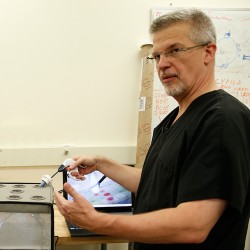With the flick of a tiny mechanical wrist, a team of engineers and doctors at Vanderbilt University’s Medical Engineering and Discovery Laboratory hope to give needlescopic surgery a whole new degree of dexterity.
Needlescopic surgery, which uses surgical instruments shrunk to the diameter of a sewing needle, is the ultimate form of minimally invasive surgery. The needle-sized incisions it requires are so small that they can be sealed with surgical tape and usually heal without leaving a scar.
Although it’s been around since the 1990s, the technique, which is also called mini- or micro-laparoscopy, is so difficult that only a handful of surgeons around the world use it regularly. In addition, it has largely been limited to scraping away diseased tissue with sharp-edged rings called curettes or burning it away with tiny lasers or heated wires.

So a research team headed by Associate Professor of Mechanical Engineering Robert Webster has developed a surgical robot with steerable needles equipped with wrists that are less than 1/16th of an inch (2 mm) thick. The achievement is described in a paper titled “A wrist for needle-sized surgical robots” presented in May at the International Conference on Robotics and Automation in Seattle.
The new device is designed to provide needlescopic tools with a degree of dexterity that they have previously lacked. Not only will this allow surgeon-operators to perform a number of procedures such as precise resections and suturing that haven’t been possible before, but it will also allow the use of needles in places that have been beyond their reach, such as the nose, throat, ears and brain.

“The smaller you can make surgical instruments the better…as long as you can maintain an adequate degree of dexterity,” said Professor of Urological Surgery S. Duke Herrell, who is consulting on the project. “In my experience, the smaller the instruments, the less post-operative pain patients experience and the faster they recover.”
That has certainly been the case with traditional minimally invasive surgery (MIS), which has become increasingly common in recent years. This method, which involves operating with instruments inserted through incisions that range from 3/8th to 3/16th of an inch (10 mm to 5 mm), generally causes patients less pain, less tissue damage, less scarring and shorter recovery periods.
The effort to adapt robotic technology to MIS has been dominated by Intuitive Surgical’s da Vinci Surgical System, a robotic surgical system designed specifically for the minimally invasive approach. Depending on the type of surgery, it requires incisions that are 1/3 of an inch (8 mm) or 3/16th of an inch (5 mm).
“Although it works very well for abdominal surgery, the da Vinci uses a wire-and-pulley system that is extremely difficult to miniaturize any further, so it won’t work in smaller spaces like the head and neck,” said Webster.
For the past six years, Webster and his colleagues have been developing a surgical robot that uses “steerable needles.” This is a system of telescoping tubes that are made out of nitinol, a “memory metal” that retains it shape. Each tube has a different intrinsic curvature. By precisely rotating, extending and retracting the tubes, an operator can steer the tip in different directions, allowing it to follow a curving path through the body.
This design allows the needles to operate in areas of the body that neither manual endoscopic instruments, which are straight rods equipped with a variety of end effectors, nor the da Vinci robot can reach. However, its usefulness was limited by the fact that the needles didn’t have a wrist.
“Adding the wrists to the steerable needles greatly expands the system’s usefulness,” Herrell said. “There are a myriad of potential applications in some really exciting areas such as endoscopic neurosurgery, operating within small lumens such as the ear, bronchus, urethra, etc. This would allow us to do surgeries that at present require much larger incisions and may even enable us to perform operations that are not feasible at present.”
The researchers made a number of unsuccessful attempts to build mechanical wrists that were small enough. “We kept trying to build the wrists out of a lot of small pieces, but we couldn’t get them to work up to our standards,” said Webster.
“Then we realized we had to start thinking outside of the box,” said graduate student Philip Swaney. “Instead of combining a bunch of pieces, we started with a tiny nitinol tube and began thinking about what we had to remove.”
The tube is extremely rigid, but they discovered that if they cut a series of tiny slots down one side, the rigidity decreased substantially: Enough, in fact, so they could get it to bend up to 90 degrees by pulling on a small wire that runs inside the tube that is attached at the tip. The wrist springs back to a straight position when tension on the wire is released.

“Once we got the idea, we realized it could be a real game changer so we had to build it,” Swaney said.
Vanderbilt University applied for a provisional patent on the design in May.
Team members would like to test the system by using it for “transnasal” surgery: operations to remove tumors in the pituitary gland and at the skull base that traditionally involve cutting large openings in a patient’s skull and/or face. Studies have shown that using an endoscope to go through the nasal cavity is less traumatic, but the procedure is so difficult that only a handful of surgeons have mastered it.
“It should be useful for a number of other operations as well,” said Webster. “We think once we give this tool to surgeons they will find all kinds of applications we haven’t thought of.”
By the end of the summer, they hope to have completed the control software and the interface that allows the surgeons to operate the device. They are actively looking for a commercial partner who will take the new instrument through the FDA approval process including initial clinical trials. “Our best case scenario is that the system could be available to surgeons in four to five years,” Webster said.
The research was supported by National Institutes of Health grant R01 EB017467.